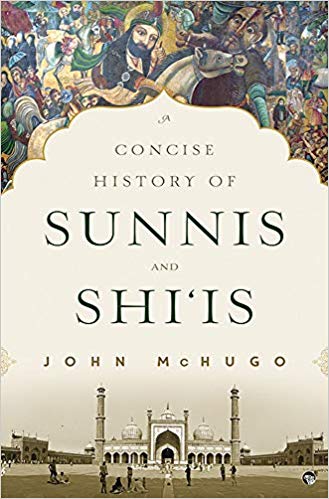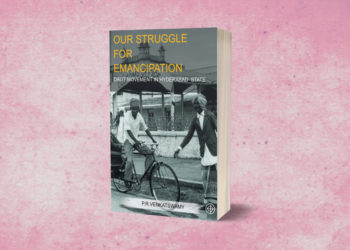The 1400-year-old schism between Sunnis and Shi’is has rarely been as toxic as it is today, feeding wars and communal strife in Syria, Iraq, Yemen, Pakistan, Afghanistan and many other countries, with tensions between Saudi Arabia and Iran escalating. India, too, has not emerged unscathed from this schism, and has witnessed periodic violence between the two sects throughout history.
In A Concise History of Sunnis and Shi’is, John McHugo reveals how this great divide occured. Charting the story of Islam from the lifetime of the Prophet Muhammad to the present day, he describes the conflicts that raged over the succession to the Prophet, how Sunnism and Shi’ism evolved as different sects during the Abbasid caliphate, and how the rivalry between the empires of Sunni Ottomans and Shi’i Safavids contrived to ensure that the split would cotinue into modern times.
The following are excerpts from chapters “In the Beginning: Before There Were Sunnis and Shi’is” and “From the Iraninan Revolution to the 2003 Invasion of Iraq” of the book.

The split in Islam between Sunnis and Shi‘is is often traced back to the question of who should have led the Muslim community after the death of the Prophet Muhammad in 632 ad. Failure to resolve that question to the satisfaction of all resulted in a great scandal: a civil war among Muslims over the leadership of the community. This began less than twenty-five years after the Prophet had been placed in his grave, and while there were still many people alive who had known him well and loved him.
One side to that civil war is often presented today as consisting of those who said that Muslims should choose the best available leader for their community. There were only two provisos. The first was that he should be a leading figure who was known for his devotion to the faith. This meant that he should be chosen from among the Prophet’s eminent Companions while they still lived. The other was that he must be from the tribe of the Quraysh to which Muhammad had belonged. This requirement may seem rather unnecessary to a modern reader who is unfamiliar with the history of Islam, but there were sound reasons for it at the time, as we shall see. The opposing party, it is frequently said, was made up of those who argued that leadership could be provided only by someone who was in the bloodline of the Prophet: initially, his cousin Ali, who was his closest living male relative at the time of his death and was married to his daughter Fatima. According to this view, the community should thenceforth always be led by a male descendant of that union.
Looked at this way, the dispute appears as much political as religious. It can even be interpreted as the pitting of those who favoured a somewhat more democratic form of religious authority (the Sunnis) against those who supported a strictly monarchical one (the Shi‘is). As time passed, the split would appear to take the form, at least on the surface, of struggles between rival dynasties. Yet there has not been a caliph with a strong claim to universal acceptance among Sunni Muslims since 1258, the year in which Hulegu the Mongol sacked Baghdad. According to the most widely known account, he ordered the last of the Abbasid caliphs to be wrapped in a carpet and trampled to death by a soldier on horseback. This form of execution was chosen because Mongol protocol dictated that royal blood should not be seen to be spilled. As for the Shi‘is, apart from a few groups such as the Ismaili followers of the Aga Khan who are a small minority even among them, none today pledge their allegiance to a worldwide religious community in which the supreme authority is a living descendant of Ali and Fatima.
Yet today the division between Sunnis and Shi‘is seems very much alive. It is frequently seen as an important aspect of the conflicts that have been ravaging Syria and Iraq over the past few years, and of the power politics playing out between Saudi Arabia and Iran. There must therefore be something more behind it than ancient civil wars and half- forgotten dynasties. We have to follow the history from the beginning right through to the present if we wish to understand the division and its impact on us now. Over time, incompatible narratives to explain the history of the early Muslim community emerged. These would split Islam. In Islam, as perhaps in other religions, history and theology became permanently intertwined.
[…]
Palestine was an interesting case. The Shah had been a close friend of Israel, seeing it as a valuable strategic ally as he tried to establish Iranian hegemony in the Gulf. Khomeini, by contrast, had been known as an outspoken supporter of Palestinian rights well before the Islamic revolution. As Shi‘is were a tiny minority among Palestinian Muslims, it was inevitable that Palestinian Islamist movements would be Sunni. Yet for some Palestinian Sunni Islamists the Iranian Revolution was an inspiration. Fathi Shiqaqi was the leader of Palestinian Islamic Jihad, a movement set up in 1980 with a programme of immediate armed struggle against Israel. In those early days, Islamist movements among Palestinians were sometimes encouraged by Israel, which saw them as a useful antidote to Arab nationalism. Shiqaqi contrasted the boldness and willingness to innovate shown by Khomeini, with the tepid and indecisive attitude of Sunni Islamists, who were all too frequently preoccupied with the minutiae of religious observance.
For Shiqaqi, Khomeini was ‘the man of the century’. He had turned Islam into a faith for those prepared to fight and sacrifice their lives for justice. He had also correctly identified the Palestinian call for justice as the point around which the struggle between Islam and the West revolved, whereas so many of the Sunni Islamists were more concerned with domestic political struggles in their own countries. The result was that, for Shiqaqi, Tehran had acquired the right to political leadership of the Muslim world in a way that transcended geographic, ethnic and sectarian boundaries. Shiqaqi saw Khomeini as a disciple of Jamal al- Din al-Afghani, and argued that he had ensured that there would be no purely sectarian identity in the Iranian Revolution. On the contrary, the Iranian Revolution had been formulated on the basis of the Qur’an. Sunnis, as well as Shi‘is, could line up behind it.1 After Hamas (a Sunni organisation) emerged from the Palestinian branch of the Muslim Brotherhood in 1987, it, too, would receive generous support from Iran. This would continue across the decades.
In Egypt, where the number of Shi‘is was extremely small, the Iranian Revolution actually hindered Sunni-Shi‘i relations, for reasons that are not hard to fathom. In 1947 some Sunni-Shi‘i dialogue began, when the Association for the Rapprochement of the Islamic Doctrinal Law Schools was established by an Iranian scholar, Muhammad Taqi al-Qummi. With government encouragement during the Nasser era, attempts were made to reach out to Iranian Shi‘is. Possibly as a result of this, in 1959 the rector of the Al-Azhar Mosque in Cairo, Sheikh Mahmud Shaltut, issued a fatwa that Twelver Shi‘is should be seen as a fifth doctrinal law school alongside the Malikis, Hanafis, Shafi‘is and Hanbalis of Sunni Islam. This, of course, echoed earlier attempts at ecumenism such as those at the time of the powerful Iranian ruler Nadir Shah. Shaltut stated that in his view conversion from Twelver Shi‘ism to one of the four traditional Sunni doctrinal law schools or vice-versa was permissible. Subsequently, however, after Egypt broke off diplomatic relations with Iran in 1960, anti-Shi‘i religious polemic reappeared. This intensified after the Iranian Revolution, when the Egyptian government saw the new Iran and the export of its revolution as a major threat.
From the 1980s onwards, a few Egyptians have publicly announced their conversion to Shi‘ism. This has caused outrage and led to passionate calls for an end to all Shi‘i missionary activities and the banning of Shi‘i publications. The desire for taqrib, or ‘rapprochement’, and the restoration of the unity of Islam has been countered by the fear of fitna, civil strife and subversion. It is not hard to see political subtexts behind official attitudes to Shi‘ism in Egypt, including behind those expressed by the Al-Azhar Mosque. On the one hand there is genuine fear of subversion spreading from Iran. This is coupled with a kind of guilt that, since the time of President Sadat’s peace treaty with Israel in 1979, Egypt has been complicit in fostering policies of Western governments in the region. Those policies are widely perceived as benefiting the interests of those governments, and not those of the people of the region, with the consequence that Egypt has failed in its duty to stand up for the oppressed. On the other hand, the steady Wahhabisation of Egyptian Islam at a popular level, which has followed on from the rise of Saudi Arabia as the wealthiest oil-producing state, has made rapprochement between Sunnis and Shi‘is harder in Egypt, as it has elsewhere. In this respect, a revealing suggestion was put forward in 2007 by Sheikh Muhammad Sayyid Tantawi, a former rector of the Al-Azhar Mosque: that reverence for those of the Prophet’s Companions who are rejected by Shi‘is should be considered an essential part of a Muslim’s faith.2 It will have made rapprochement with Shi‘is much harder, but would have been well received in Saudi Arabia, which is a major donor of aid to Egypt.
In Syria, the Iranian Revolution had paradoxical consequences. In June 1979, a disaffected Sunni Ba‘athist let militants into the artillery academy in Aleppo, where they shot and killed at least thirty-two officer cadets who were chiefly Alawis. The artillery school massacre was a major escalation in the low-intensity guerrilla war already waged against the Syrian regime by Islamist militants inspired by the ideas of Sayyid Qutb. These militants were the Fighting Vanguard, an offshoot of the Muslim Brotherhood founded by followers of Marwan Hadid, a Muslim Brother from Hama. Hadid, unusually for a Syrian Muslim Brother, had been advocating the violent overthrow of the Ba‘athists for a decade, before he died in regime custody in 1976. After the artillery school massacre, violence grew worse. In June 1980 an assassination attempt on President Hafez al-Assad nearly succeeded, and a mass execution of Islamist detainees in the notorious prison of Palmyra took place in retaliation. There were also attempts on the lives of other prominent Alawis and some leading Sunni religious scholars who supported Assad’s regime. Some of these were successful.
The culmination of the unrest was the uprising in Hama in February 1982 when the Fighting Vanguard and local members of the Muslim Brotherhood seized control and slaughtered dozens of local Ba‘athist officials. Their hope was to spark similar uprisings across Syria, but these did not occur. The regime’s response was brutal and comprehensive. Thousands of ordinary men, women and children died in the indiscriminate shelling by the regime’s tanks before it retook control. The lowest estimate for those who died in the regime’s recapture of Hama is 5,000, while figures of 10,000–20,000 (or even higher – up to 40,000) are frequently cited.
The Hama uprising and the violent campaign that preceded it was an attack on the kind of secularist regime against which Sayyid Qutb had advocated violence. At the same time, many of the members of the Fighting Vanguard who fought it had also been inspired by the Iranian Revolution. Specifically Sunni and Shi‘i revolutionary currents had thus come together against the secularist Ba‘ath of Hafez al-Assad. There was also another paradox. While the centre of Hama was being consumed by fire, the Iran-Iraq War was in progress and the Iranians were now on the offensive. The Syrian regime was revolutionary Iran’s major Arab ally throughout that conflict. Only a couple of months after the uprising had been crushed, Syria would help Iran by closing the pipeline for Iraqi oil exports that crossed its territory.
1. M. Hatina, ‘Debating the “Awakening Shi’a'”: Sunni Perceptions of the Iranian Revolution’, in Bengio and Litvak, pp. 205-07.
2. R. Brunner, ‘Egypt and Shi’ism at the Beginning of the Twenty-First Century’, in Bengio and Litvak, pp. 231-32.
Read More:
The Rattle of the Bones (2002)
“We shared a past in three countries and two languages”
“The history of India is a history of mortal conflict between Buddhism and Brahmanism.”




